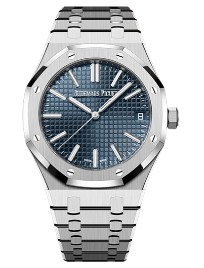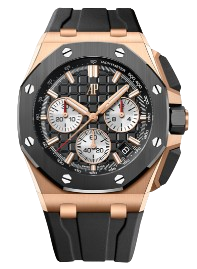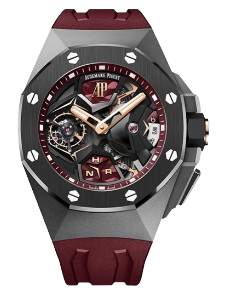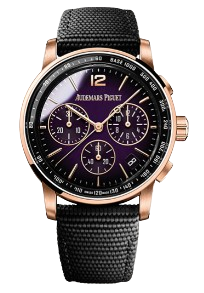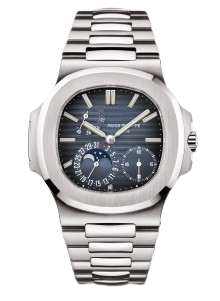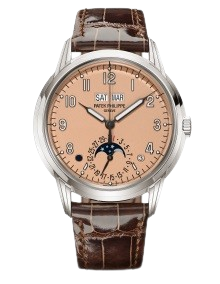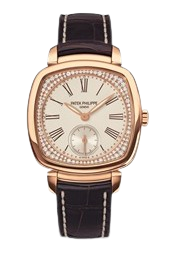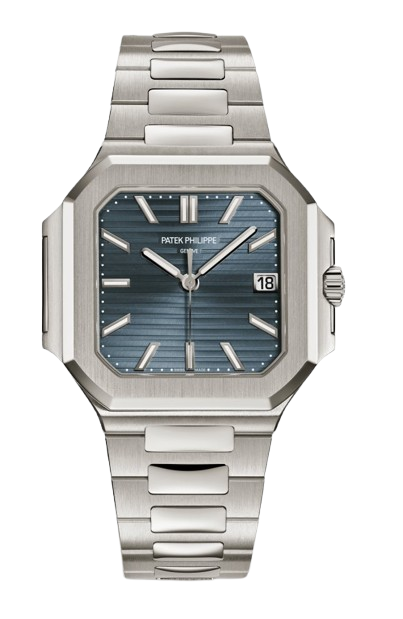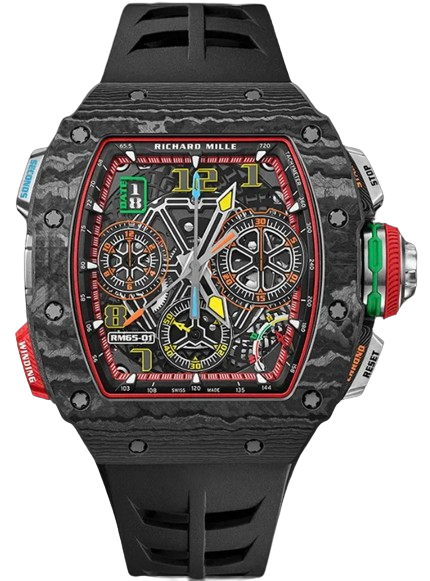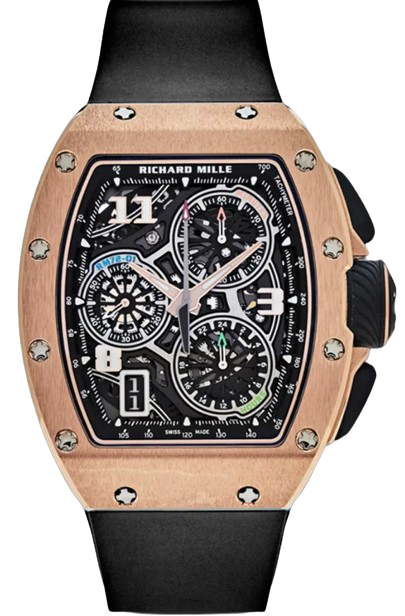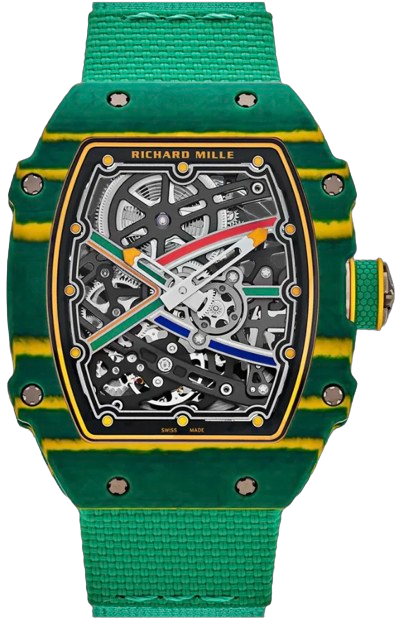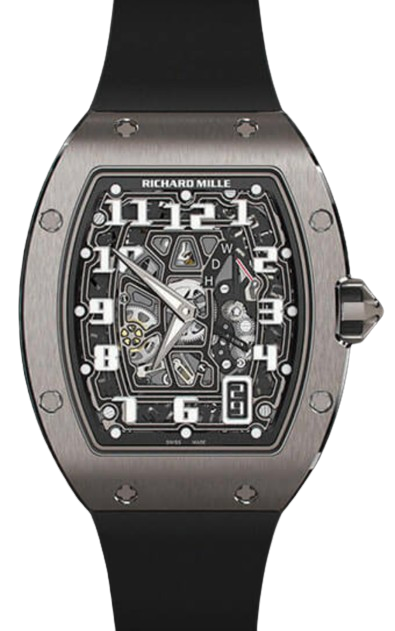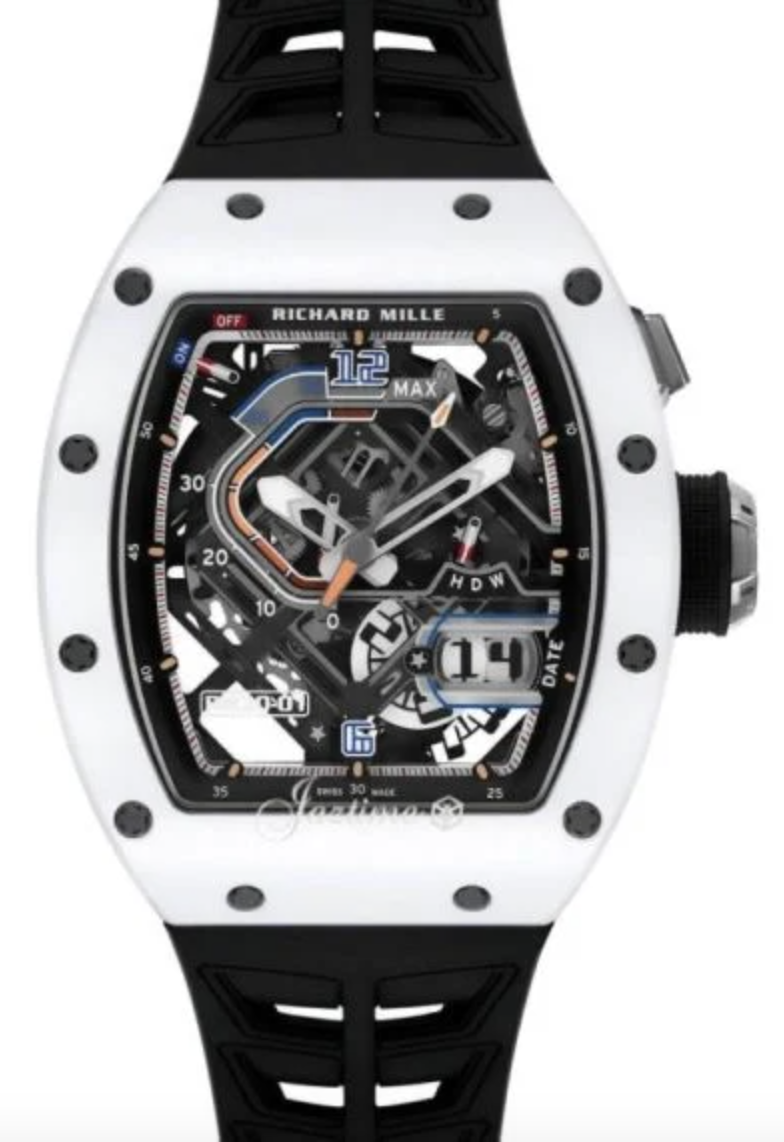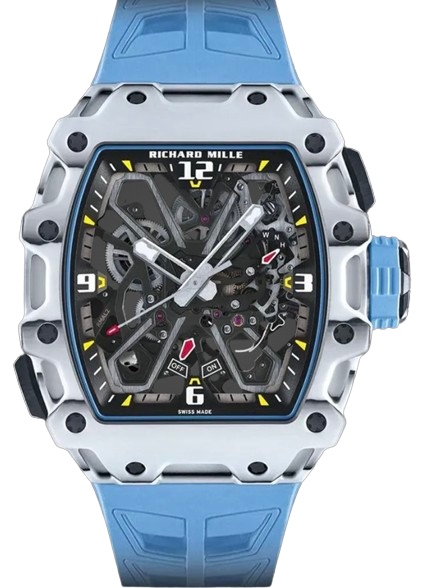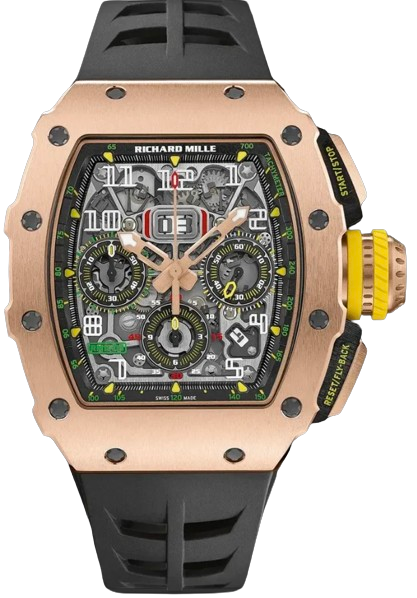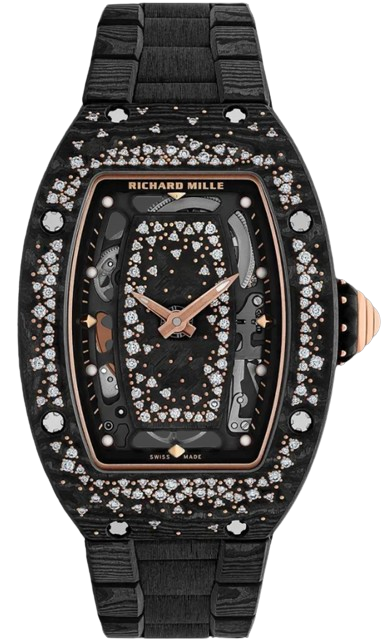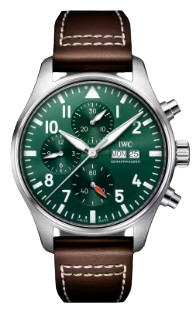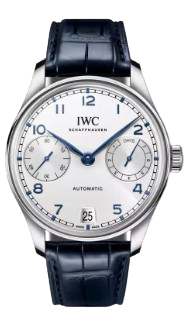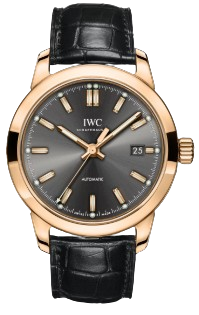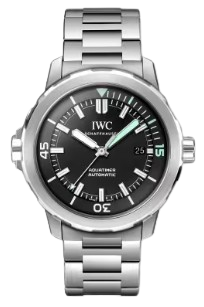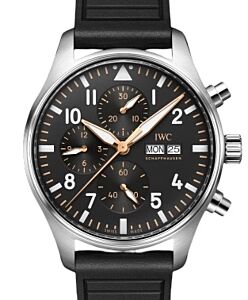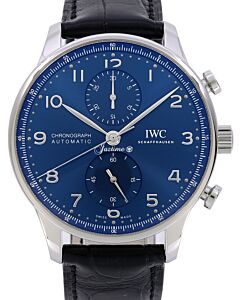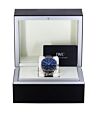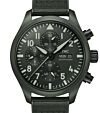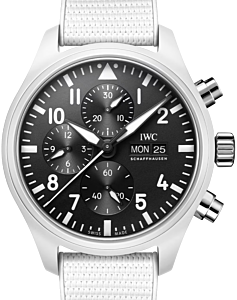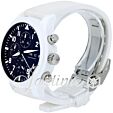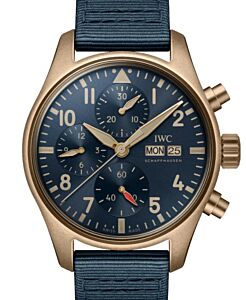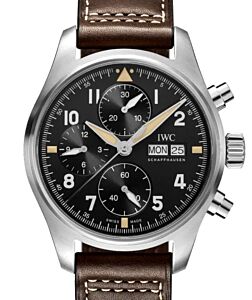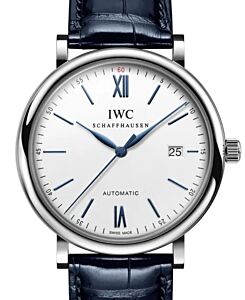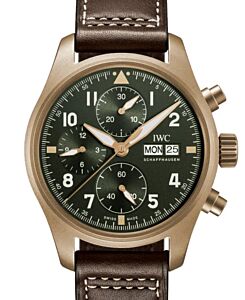IWC
IWC WATCHES
|
The International Watch Company (IWC) is one of the most historic watch manufacturers around. IWC was established in 1868 by... the American watch designer, Florentine Ariosto Jones. Famed for combining high-quality craftsmanship with beautiful designs, IWC is also notable for being the only major luxury Swiss manufacturer to be based in the east of Switzerland. Typically, IWC timepieces benefit from classic designs and legible watch faces, which combine to help give them a timeless appeal. Historically, the company's models were primarily aimed at men, although this has changed in more recent years, with many of the Portofino models, in particular, exhibiting more feminine features. Read more Show less |
- IWC Pilot's Watch Chronograph APXGP Steel 43mm Black Dial IW378009 IWC Pilot's Watch Chronograph APXGP Steel 43mm Black Dial IW378009Retail Price: Regular Price $7,400 Save: $401 (5%) Our Price: Special Price $6,999
- IWC Pilot’s Watch Mark XX Mercedes-AMG PETRONAS Formula One™ Team Titanium 40mm Black Dial IW328210 IWC Pilot’s Watch Mark XX ... Team Titanium 40mm Black Dial IW328210Retail Price: Regular Price $6,400 Save: $401 (6%) Our Price: Special Price $5,999
- IWC Pilot’s Watch Performance Chronograph AMG Titanium 41mm Black Dial IW388305 IWC Pilot’s Watch Performance ... AMG Titanium 41mm Black Dial IW388305Retail Price: Regular Price $10,300 Save: $1,501 (15%) Our Price: Special Price $8,799
- IWC Portofino Chronograph Steel 39mm White Dial IW391503 IWC Portofino Chronograph Steel 39mm White Dial IW391503Retail Price: Regular Price $8,200 Save: $1,301 (16%) Our Price: Special Price $6,899
- IWC Portugieser Chronograph 41mm Horizon Dune Dial IW371624 IWC Portugieser Chronograph 41mm Horizon Dune Dial IW371624Retail Price: Regular Price $8,400 Save: $901 (11%) Our Price: Special Price $7,499
- IWC Pilot's Watch Chronograph Top Gun Ceratanium 41mm IW388106 IWC Pilot's Watch Chronograph Top Gun Ceratanium 41mm IW388106Retail Price: Regular Price $13,100 Save: $2,101 (16%) Our Price: Special Price $10,999
- IWC Portofino Chronograph Stainless Steel 39mm Blue Dial IW391408 IWC Portofino Chronograph Stainless Steel 39mm Blue Dial IW391408Retail Price: Regular Price $6,500 Save: $901 (14%) Our Price: Special Price $5,599
- IWC Portugieser Chronograph Stainless Steel 41mm Blue Dial IW371606 - PRE OWNED IWC Portugieser Chronograph Stainless Steel 41mm Blue Dial IW371606 - PRE OWNEDRetail Price: Regular Price $8,400 Save: $1,801 (21%) Our Price: Special Price $6,599
- IWC Pilot's Watch Chronograph Top Gun Woodland Ceramic 44.5mm Green Dial IW389106 IWC Pilot's Watch Chronograph Top ... Ceramic 44.5mm Green Dial IW389106Retail Price: Regular Price $12,300 Save: $1,801 (15%) Our Price: Special Price $10,499
- IWC Pilot's Watch Chronograph Steel 43mm Green Dial Bracelet IW378006 IWC Pilot's Watch Chronograph Steel 43mm Green Dial Bracelet IW378006Retail Price: Regular Price $8,300 Save: $901 (11%) Our Price: Special Price $7,399
- IWC Pilot's Watch Chronograph Steel 43mm Green Dial Leather Strap IW378005 IWC Pilot's Watch Chronograph Steel 43mm Green Dial Leather Strap IW378005Retail Price: Regular Price $7,400 Save: $701 (9%) Our Price: Special Price $6,699
- IWC Pilot's Watch Chronograph Edition "AMG" Titanium 43mm Black Dial Leather Strap IW377903 IWC Pilot's Watch Chronograph ... 43mm Black Dial Leather Strap IW377903Retail Price: Regular Price $9,350 Save: $1,551 (17%) Our Price: Special Price $7,799
- IWC Portugieser Automatic 40 Steel Pink Dial Leather Strap IW358313 IWC Portugieser Automatic 40 Steel Pink Dial Leather Strap IW358313Retail Price: Regular Price $7,300 Save: $1,101 (15%) Our Price: Special Price $6,199
- IWC Pilot's Watch Chronograph Top Gun "Lake Tahoe" Ceramic 44.5mm Black Dial IW389105 IWC Pilot's Watch Chronograph Top ... Ceramic 44.5mm Black Dial IW389105Retail Price: Regular Price $12,300 Save: $1,301 (11%) Our Price: Special Price $10,999
- IWC Pilot's Watch Chronograph 41 Stainless Steel Black Dial Leather Strap IW388111 IWC Pilot's Watch Chronograph 41 ... Steel Black Dial Leather Strap IW388111Retail Price: Regular Price $7,200 Save: $901 (13%) Our Price: Special Price $6,299
- IWC Pilot's Watch Chronograph Stainless Steel 43mm Blue Dial Bracelet IW378004 IWC Pilot's Watch Chronograph ... Steel 43mm Blue Dial Bracelet IW378004Retail Price: Regular Price $8,300 Save: $1,301 (16%) Our Price: Special Price $6,999
- IWC Portofino Chronograph Stainless Steel 39mm Silver Dial IW391406 IWC Portofino Chronograph Stainless Steel 39mm Silver Dial IW391406Retail Price: Regular Price $6,500 Save: $901 (14%) Our Price: Special Price $5,599
- IWC Portofino Chronograph Stainless Steel 39mm Green Dial IW391405 IWC Portofino Chronograph Stainless Steel 39mm Green Dial IW391405Retail Price: Regular Price $6,500 Save: $1,001 (15%) Our Price: Special Price $5,499
- IWC Portugieser Chronograph Stainless Steel 41mm Silver Dial IW371620 IWC Portugieser Chronograph Stainless Steel 41mm Silver Dial IW371620Retail Price: Regular Price $8,400 Save: $1,501 (18%) Our Price: Special Price $6,899
- IWC Pilot's Watch Chronograph 41 Bronze Blue Dial IW388109 IWC Pilot's Watch Chronograph 41 Bronze Blue Dial IW388109Retail Price: Regular Price $7,800 Save: $1,201 (15%) Our Price: Special Price $6,599
- IWC Pilot's Watch Chronograph "Spitfire" Stainless Steel 41mm Black Dial IW387903 IWC Pilot's Watch Chronograph ... Steel 41mm Black Dial IW387903Retail Price: Regular Price $7,500 Save: $1,101 (15%) Our Price: Special Price $6,399
- IWC Pilot's Watch Chronograph Stainless Steel 43mm Black Dial IW378001 IWC Pilot's Watch Chronograph Stainless Steel 43mm Black Dial IW378001Retail Price: Regular Price $7,400 Save: $1,101 (15%) Our Price: Special Price $6,299
- IWC Portofino Automatic Stainless Steel 40mm Silver Dial IW356527 IWC Portofino Automatic Stainless Steel 40mm Silver Dial IW356527Retail Price: Regular Price $4,950 Save: $551 (11%) Our Price: Special Price $4,399
- IWC Pilot's Watch Chronograph Spitfire Bronze 41mm Green Dial IW387902 IWC Pilot's Watch Chronograph Spitfire Bronze 41mm Green Dial IW387902Retail Price: Regular Price $7,500 Save: $1,101 (15%) Our Price: Special Price $6,399
IWC Schaffhausen Brand History
|
The International Watch Company, or IWC as it is more commonly known, was founded in 1868 by the American watchmaker Florentine Ariosto Jones. The company is based in Schaffhausen, Switzerland, which is notable because it makes IWC the only big-name luxury Swiss watch manufacturer to have its headquarters in eastern Switzerland. The company has a reputation for solid craftsmanship and has historically manufactured timepieces that have enjoyed popularity within military, sports and aviation fields. In this article, we take a more detailed look at the history of the brand and some of its most notable watch models.
The first IWC WatchesIn its early years, IWC primarily developed pocket and fob watches, rather than the wristwatches the company is associated with today. Nevertheless, even in its infancy, the manufacturer had a reputation for innovation and in 1885, IWC developed a watch with a digital hours and minutes display, which was very unusual at the time. The company released its first wristwatch - 64 calibre - in 1899 and its first movements for wristwatches in 1915. However, the first major wristwatch model associated with the brand - the Special Pilot's Watch - was not launched until 1936. This particular model featured a rotating bezel with an arrowhead index for indicating take off times. Following on from the success of the Special Pilot's Watch, IWC launched the Big Pilot's Watch 52 T.S.C. in 1940. As the name suggests, this model had a large case size, measuring 55 mm in diameter, and was designed specifically for military applications. It also featured a central seconds hand, which had been missing from its predecessor.
The IWC Portuguese CollectionOne year prior to the release of the Big Pilot's Watch 52 T.S.C., two importers from Portugal - Rodrigues and Teixeira - visited the IWC headquarters and ordered a series of large stainless steel wristwatches with a level of precision that could match that of a marine chronometer. This resulted in the birth of the IWC Portuguese range. Now the most popular and instantly recognisable wristwatch in the IWC catalogue, the Portuguese began life with a 43mm case, which was considered extremely large by the standards at the time. It was powered by a 74 calibre movement, had Arabic numerals, a seconds sub-dial, a thin bezel and leaf-shaped hands. This basic aesthetic has remained in place ever since, even though the company has released a huge number of variations since the original Portuguese model. Throughout the 1940s and 1950s, Portuguese models were powered by the 90 calibre, which was a variation of the 74 calibre. Shock protection was added in the 1980s. Sales of the Portuguese line declined until 1993, when a new version was released to mark the 125th anniversary of the company. This model, Ref. 5441, had a 42mm dial and was produced in steel, gold and platinum. In 2000, the company released the Portuguese Automatic, while in 2010, a Grande Complication version was released, complete with a perpetual calendar, moon phase indicator, chronograph and minute repeater.
IWC's Timepiece InnovationsAway from the brand's flagship model, IWC's evolution continued with the release of the W. W. W. wristwatch in 1944. This model was designed for the British Army, with the initials meaning "Watch, Wrist, Waterproof". This was followed by the release of the Pilot's Watch Mark 11 in 1948, which used an updated 89 calibre movement. In 1955, another of the brand's most recognisable models, the Ingenieur, made its début. It was primarily notable for being an automatically wound model. Then, in 1967, IWC unveiled their first professional diver's watch, the Aquatimer, offering 20 bar water resistance, which was almost unrivalled at that time. Two years later, the company produced its first Quartz movement, Beta 21, and used this in a new model, known as the Da Vinci. Nevertheless, during the Quartz crisis, IWC continued to develop high-quality mechanical movements, focusing primarily on the art of watch-making, rather than the convenience of Quartz. During the late 1970s, IWC worked with the designer F.A. Porsche to create the first watch with a built-in compass and the first chronograph in a titanium case. The early 1980s also saw the introduction of the Ocean 2000 dive watch and an updated Da Vinci, which included a perpetual calendar, with four-digit year display.
New IWC Watch CollectionsIn 1986, the International Watch Company broke new ground by using zirconium oxide ceramic as a case material, offering supreme scratch resistance. This was followed a year later by the introduction of the Novecento, which was a unique, rectangular watch, with a perpetual calendar and a moon phase indicator. The beginning of the 1990s saw IWC unveil their first Grande Complication watch, which offered an array of features in one watch, including a chronograph, perpetual calendar, moon phase indicator and minute repeater. This watch truly brought the company into the modern era, having taken a total of seven years to design and produce. Updated versions of the Pilot's Watch and the Da Vinci followed in the mid-1990s, while a new sports watch line was also introduced in the form of the GST. In 1998, the Pilot's Watch received another new update with the Pilot's Watch UTC, which featured 24-hour time display and an hour hand that could be easily moved in one hour increments. Moving into the new millennium, IWC re-visited their Big Pilot's Watch in 2002, releasing a newly updated version with an impressive 7-day power reserve feature. The Aquatimer line was also relaunched in 2004, while 2007 saw the release of the new Da Vinci collection, which now utilised a distinctive tonneau shaped case. |
Pre-Owned and Used IWC Watches
IWC Watches by Strap
- Leather Strap - IWC Watches
- Blue Leather Strap - IWC Watches
- Brown Leather Strap - IWC Watches
- Le Petit Prince Brown Leather Strap - IWC Watches
- Classic Brown Leather Strap - IWC Watches
- Classic Black Leather Strap - IWC Watches
- Classic Stainless Steel Bracelet - IWC Watches
- Portugieser Leather Strap - IWC Watches
- Portugieser Black Leather Strap - IWC Watches
- Portugieser Brown Leather Strap - IWC Watches
- Portugieser Blue Leather Strap - IWC Watches
- Da Vinci Brown Leather Strap- IWC Watches
- Da Vinci Black Leather Strap - IWC Watches
- Da Vinci Blue Leather Strap - IWC Watches
- Da Vinci Stainless Steel Bracelet - IWC Watches
- Ingenieur Black Leather Strap - IWC Watches
- Da Vinci Blue Leather Strap - IWC Watches
- Rubber Strap - IWC Watches
- Aquatimer Rubber Strap - IWC Watches
IWC Watches by Dial Color
IWC Watches by Case Material
- Stainless Steel Case - IWC Watches
- Rose Gold - IWC Watches
- Le Petit Prince Stainless Steel Case - IWC Watches
- Portugieser Stainless Steel Case - IWC Watches
- Portofino Steel Case - IWC Watches
- Portofino Rose Gold Case - IWC Watches
- Da Vinci Stainless Steel Case - IWC Watches
- Da Vinci Rose Gold Case - IWC Watches
- Ingenieur Stainless Steel Case - IWC Watches
- Ingenieur Rose Gold Case - IWC Watches
IWC Watches by Case Size
- 34mm - IWC Watches
- 36mm - IWC Watches
- 37mm - IWC Watches
- 39mm - IWC Watches
- 40mm - IWC Watches
- 40.4mm - IWC Watches
- 40.9mm - IWC Watches
- 41mm - IWC Watches
- 42mm - IWC Watches
- 43mm - IWC Watches
- 43.5mm - IWC Watches
- 44mm - IWC Watches
- 44.5mm - IWC Watches
- 45mm - IWC Watches
- 46.5mm - IWC Watches
IWC Portugieser Watches by Case Size
- Portugieser 40.4mm - IWC Watches
- Portugieser 40.9mm - IWC Watches
- Portugieser 41mm - IWC Watches
- Portugieser 42mm - IWC Watches
- Portugieser 43.5mm - IWC Watches
IWC Pilot's Watch by Case Size
- Pilot's Watch40mm - IWC Watches
- Pilot's Watch44mm - IWC Watches
- Pilot's Watch50mm - IWC Watches
- Pilot's Watch40mm - IWC Watches
- Pilot's Watch44mm - IWC Watches
- Pilot's Watch50mm - IWC Watches
IWC Portofino Watches by Case Size
- Portofino 34mm - IWC Watches
- Portofino 37mm - IWC Watches
- Portofino 40mm - IWC Watches
- Portofino 42mm - IWC Watches
- Portofino 43mm - IWC Watches
- Portofino 45mm - IWC Watches
IWC Da Vinci Watches by Case Size
- Da Vinci 36mm - IWC Watches
- Da Vinci 40.2mm - IWC Watches
- Da Vinci 42mm - IWC Watches
- Da Vinci 43mm - IWC Watches
IWC Ingenieur Watches by Case Size
IWC Aquatimer Watches by Case Size
- Da Vinci 42mm - IWC Watches
- Da Vinci 45mm - IWC Watches
- Da Vinci 47mm - IWC Watches
- Da Vinci 48mm - IWC Watches
- Da Vinci 49mm - IWC Watches
IWC Pilot Spitfire Watches by Dial Color
- Da Vinci 42mm - IWC Watches
- Da Vinci 45mm - IWC Watches
- Da Vinci 47mm - IWC Watches
- Da Vinci 48mm - IWC Watches
- Da Vinci 49mm - IWC Watches
IWC Watches by Model
- Portugieser - IWC Watches
- Pilot's Watch - IWC Watches
- Portofino - IWC Watches
- Da Vinci - IWC Watches
- Ingenieur - IWC Watches
- Aquatimer - IWC Watches
- Pilot's Watch Spitfire - IWC Watches
- Pilot's Watch Top Gun - IWC Watches
- Pilot's Watch Le Petit Prince - IWC Watches


